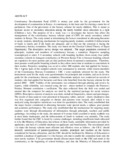| dc.description.abstract | Constituency Development Fund (CDF) is money put aside by the government for the
development of communities in Kenya
.A constituency is the basic unit for electing a mem
ber of
parliament.
One of the provisions is the bursary scheme for needy children. This is meant to
increase access to secondary education among the needy families
since education is a right
(Children’s Act).
The purpose of th
e
study was t
o
investigate
the
factors
that affect the
management of the constituency bursary scheme
(part of CDF)
for
needy
secondary school
students in
Kenya.
The study aimed at determining the factors considered in allocating bursaries
to needy students, identifying mechanisms for targeting needy students, establish if disbursement
of funds is timely and if the funds are adequate, and to find out the constrain
ts facing the
constituency bursary committee. The study was based on the Classical Liberal Theory of Equal
Opportunity. The descriptive survey design
was adopted
. The target population consisted of
principals, students and members of constituency bursary c
ommittee. Purposive sampling
wasemployed to select
1
4
secondary schools with boarding facilities from twenty four public
secondary schools in Amagoro constituency
in Western Kenya.T
his is because boarding schools
are expensive for most parents and yet they
perform better in
national
examinations
.
Therefore,
most parents would prefer boarding schools as they allow more time to students to concentrate in
their studies.
Purposive sampling was
us
ed to select 300 students who had applied for bursary.
The
1
4
princ
ipals of the sampled schools were
automatical
ly selected, while
sixteen
members of
the
Constituency Bursary Committee (
CBC
)
were randomly selected for the study.
The
instruments used for the study were
questionnaires
for
principals and students, and
an
in
terview
guide
for the constituency bursary committee. Documents analysis was conducted
on records of students who had applied for bursaries and those who benefited from the bursary
scheme for the period 2005
–
2009. Validity of the instruments was enhanced
through piloting
and review by experts, while reliability was ensured using the test
-
retest method to compute the
Pearson’s
Product Moment
correlation
s
coefficient. The data collected from the field was coded
and entered into the computer for analysis
ass
isted by
the statistical package for social sciences
(SPSS). Descriptive statistic
al
analysis was done, includ
ed
frequencies, means and percentages.
The results of data analysis were presented in frequency tables, and pie
-
charts. Qualitative data
was first
organized
into
categories
or
themes and patterns were created, after which it was
analyzed using
descriptive statisticsas was done
for quantitative data.
The study established that the major factors considered in allocating bursaries were special
needs, o
rphans, poor parents and academic performance. The study also established that the
mechanisms for targeting needy students were through dissemination of information through
principals, teachers and public gatherings. According to the study, the amount of b
ursary funds
awarded to needy students was at most times inadequate, and the disbursement of funds to
students was untimely. The study further found that the CBC is faced by various challenges,
including insufficient funds allocated to it by the Ministry
of Education, late release of these
funds, unreliable information provided by applicants, and lack of a reliable database on
applicants and beneficiaries.
The
recommend
ation
s to make the bursary scheme more efficient and effective
were as
follows
;
the CB
C should intensify sensitization of parents/guardians, students, principals and
teachers on the factors considered for bursary allocation, and
the
CBC should be facilitated by
Ministry of Education to establish a database
of applicants f
o
r
the bursary sch
eme to enable
the
committee
fund only the most needy
students
.T
he government should allocate more funds to the
CBC
and remit to the constituency
at the beginning of school holidays, and that the Ministry of
Education should strengthen the monitoring and ev
aluation structures of the bursary scheme to
ensure that it meets its objectives
of assisting the needy hence increasing access to secondary
education
.
The
conclusions of thestudy:
management of the bursary scheme is affected by
inadequacy of funds disburs
ed to CBC, inadequate communication to stakeholders, ineffective
identification of needy students and untimely disbursement of funds to CBC and students. | en_US |

